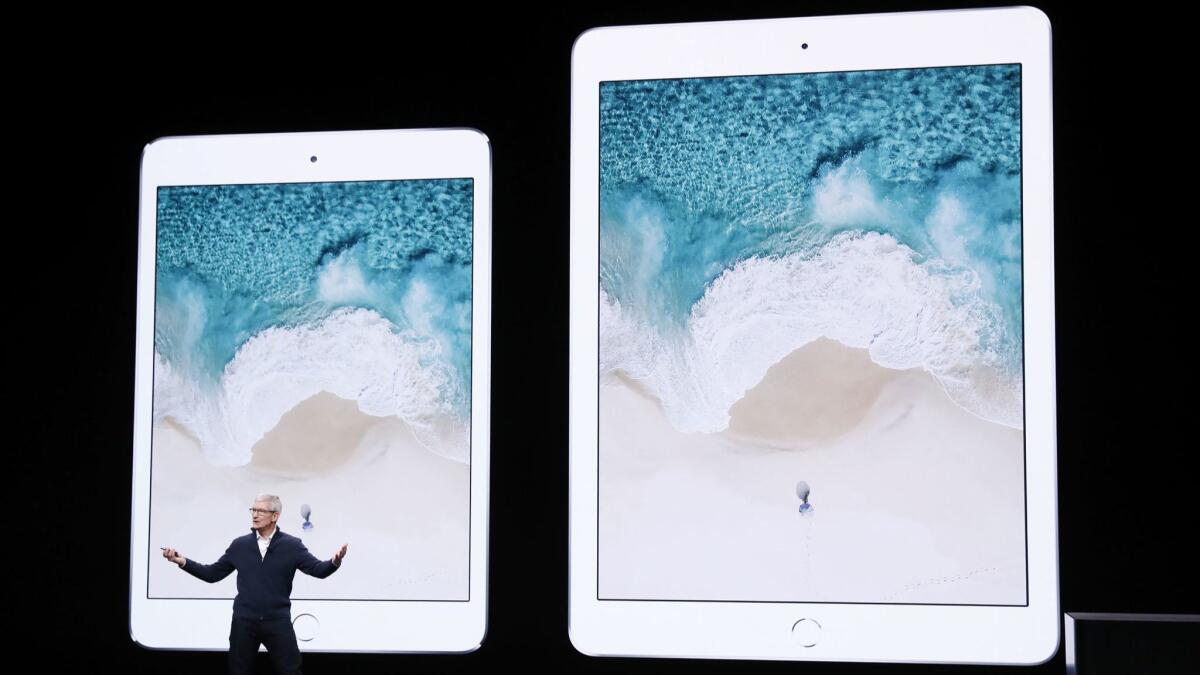Apple revamps iPad Pro and breathes new life into MacBook Air

First Apple Inc. axed the home button on the iPhone. Now it’s coming for the iPad.
At a New York City event Tuesday, the iPhone maker unveiled a redesigned version of its $800 iPad Pro for businesses and creative professionals, as well as a refreshed $1,200 MacBook Air targeting entry-level laptop buyers.
The new iPad Pro, the biggest overhaul of Apple’s tablet in years, takes design cues from the latest iPhones. The home button — present since co-founder Steve Jobs first introduced iPad in 2010 — has been replaced with a swipe-up gesture. Instead of a fingerprint reader, the iPad Pro now unlocks with FaceID, Apple’s facial-recognition technology, adapted for the iPad to work in both vertical and horizontal orientations.
With the home button out of the way, Apple filled the front margins of the iPad with more functional screen. The device has smaller edges and comes in versions with 11-inch and 12.9-inch screens, measured on the diagonal — the larger of which is about the size of an 8.5-by-11-inch sheet of paper. The smaller one starts at $800; the larger, $1,000.
Apple generates plenty of interest (and sales) any time it changes the design of one of its products. IPads now outsell Mac computers, though the overall tablet market is shrinking. The iPad’s advantage is that it packs a slender form with a big touchscreen, not available on any Macs.
The new iPad Pro — whose price is more than double that of a basic $330 9.7-inch iPad — is capable of much more than just enabling you to watch TV in bed and play games. On stage, Apple described the iPad Pro as a “magical piece of glass that can be anything you need it to be.”
Translation: The iPad Pro is a powerful, flexible computer you can carry around. It has a new processor and neural engine, and Apple says it’s faster than 92% of portable PCs. A new version of the Apple Pencil stylus connects magnetically to the side of the iPad Pro and charges through contact.
Apple said the iPad Pro could even plug into an external monitor (via a new USB-C style port) to become a portable graphics workhorse. Executives from Adobe showed how it could be used to edit a giant image with a new full-powered version of Adobe’s popular Photoshop application, arriving next year. (To underscore the usefulness of the iPad for professional creatives, Apple held its launch event at the Brooklyn Academy of Music.)
Even as Apple touted the iPad as the future of computing, it also offered up a clamshell laptop that customers have been waiting for years to see updated.
The new MacBook Air’s highlight feature is a higher-resolution 13-inch “retina” quality screen, which features four times the pixels. At 2.75 pounds, it’s a quarter of a pound lighter than the previous model, and also a bit thinner and smaller.
The refresh also includes a fingerprint reader for securely unlocking the computer, making payments and logging into apps. But some won’t be happy that the new model lacks the common USB-A style port and an SD-card reader. Instead, it has two smaller USB-C type ports that work for charging and plugging in external devices.
When Jobs first introduced the Air by pulling it out of an envelope a decade ago, it redefined laptop design and became the go-to computer for college students, boasting a thin form, long battery life and lower price. But at $1,200 and up, the new Air may have a harder time competing with Microsoft Windows PCs and Chromebooks.
Apple also said the aluminum in the new laptop comes from entirely recycled sources, a milestone in the company’s environmental efforts.
The company had no updates to its AirPod headphones, nor did it offer a status report on the AirPower wireless charging pad it announced last year but has yet to start selling.
The products it announced Tuesday are due out Nov. 7.
Fowler writes for the Washington Post.
UPDATES:
12:15 p.m.: This article was updated throughout with additional details.
9:15 a.m.: This article was updated with the Mac Mini, the new iPad Pro’s starting price and the new products’ release date.
This article was originally published at 8:35 a.m.



